Potent Skin Cancer Chemopreventing Activity of Some Novel Semi-synthetic Cembranoids from Marine Sources
Abstract
:Introduction
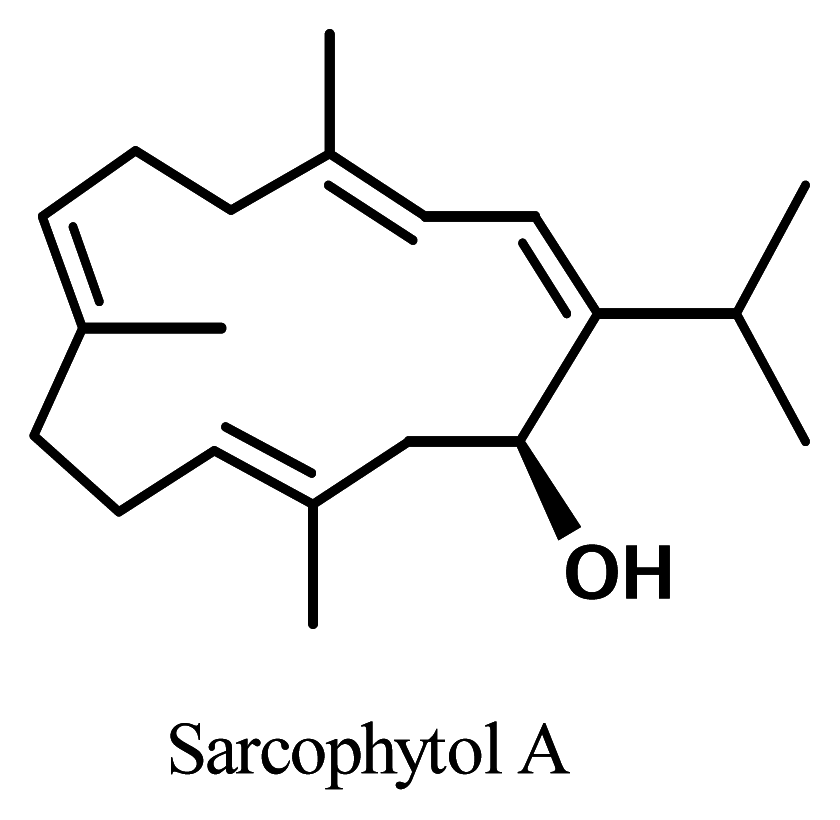
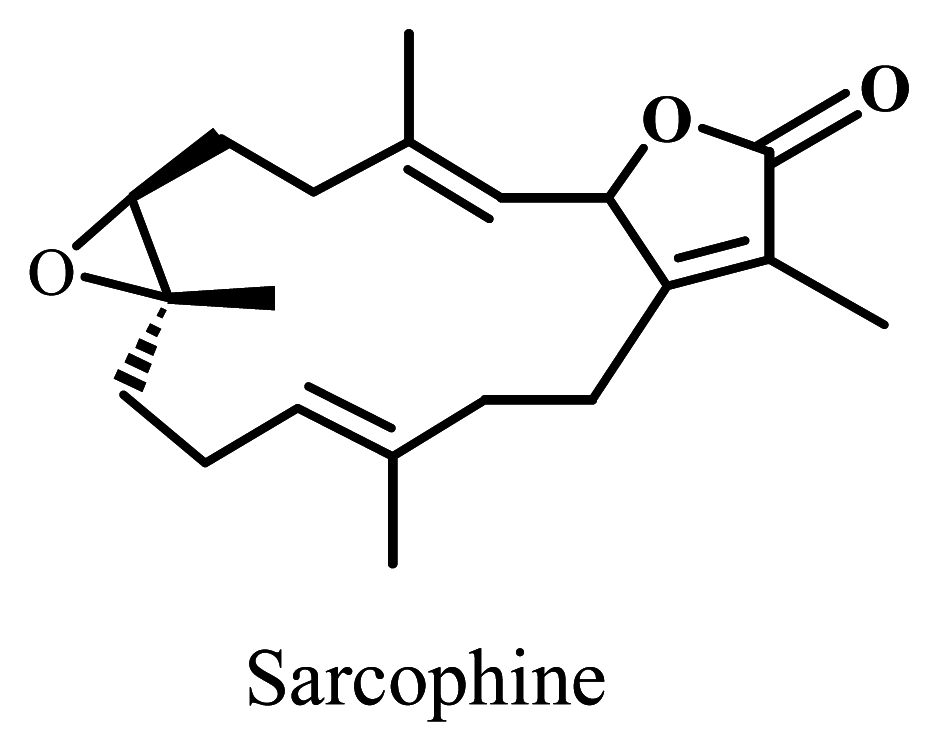
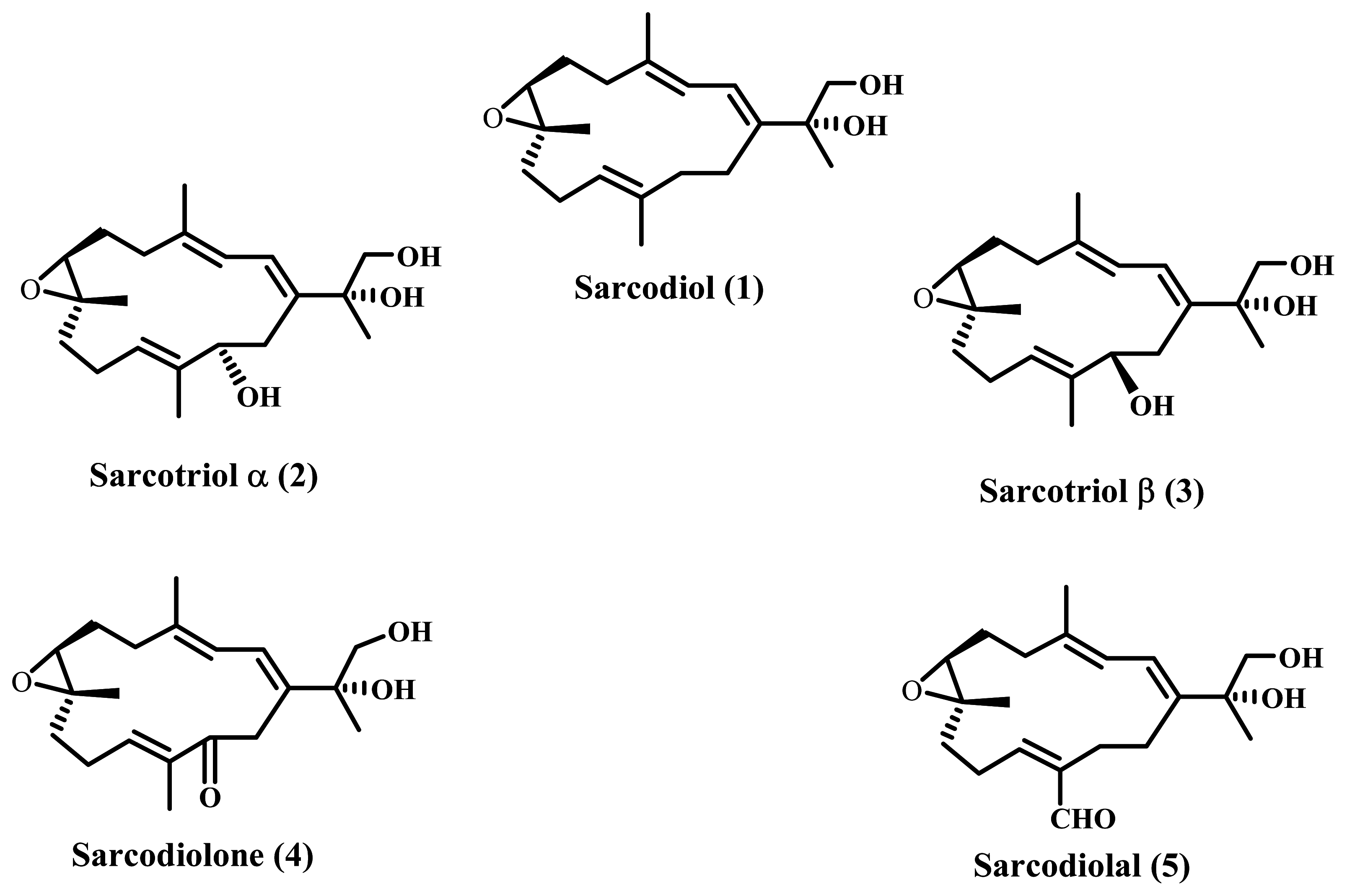
Results and Discussion
Conclusions
Experimental
General
Animals
Materials
Synthesis of compounds
Two-stage mouse skin carcinogenesis model induced by DMBA/TPA
Statistical Analysis
Cytotoxicity studies
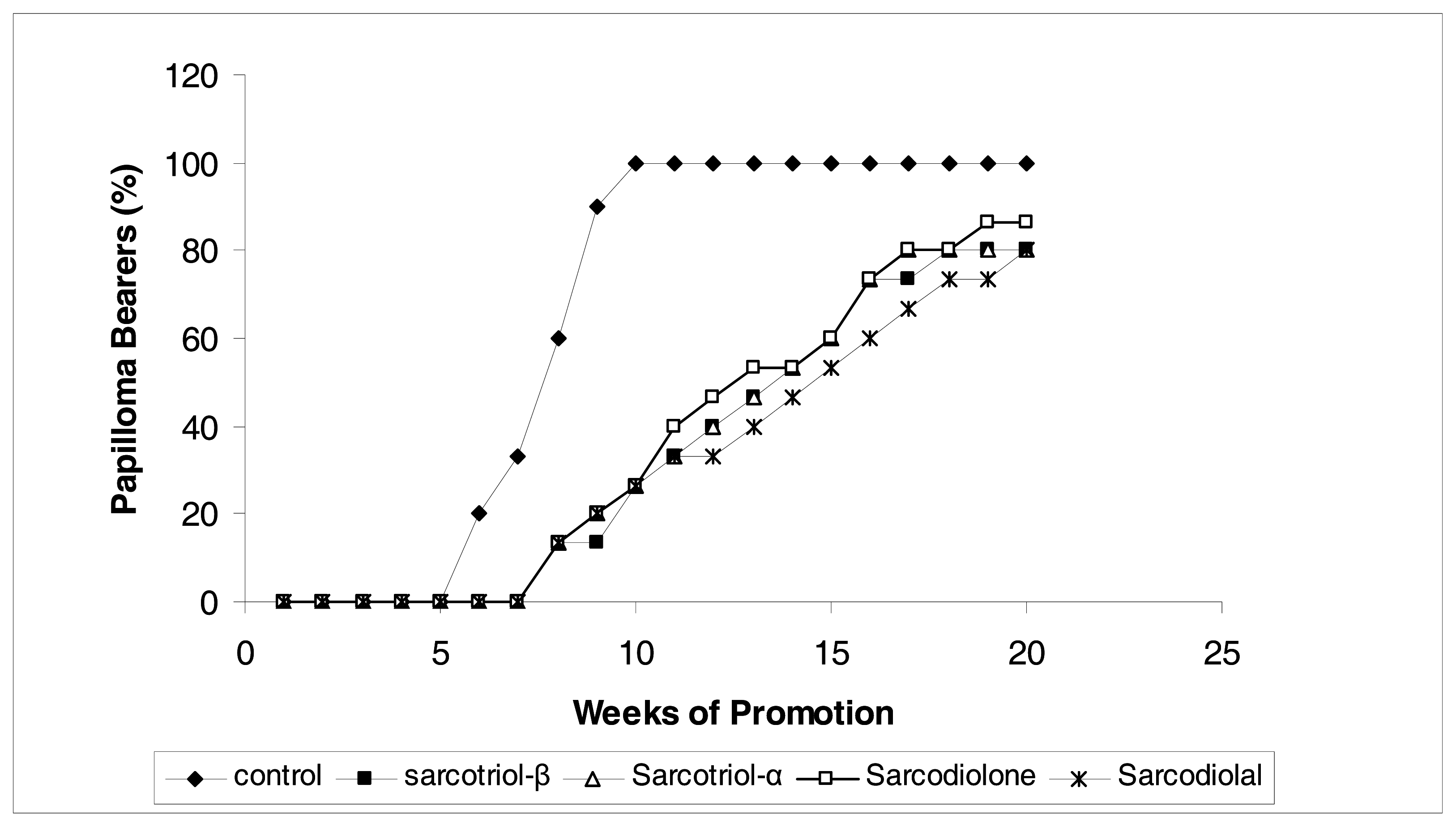
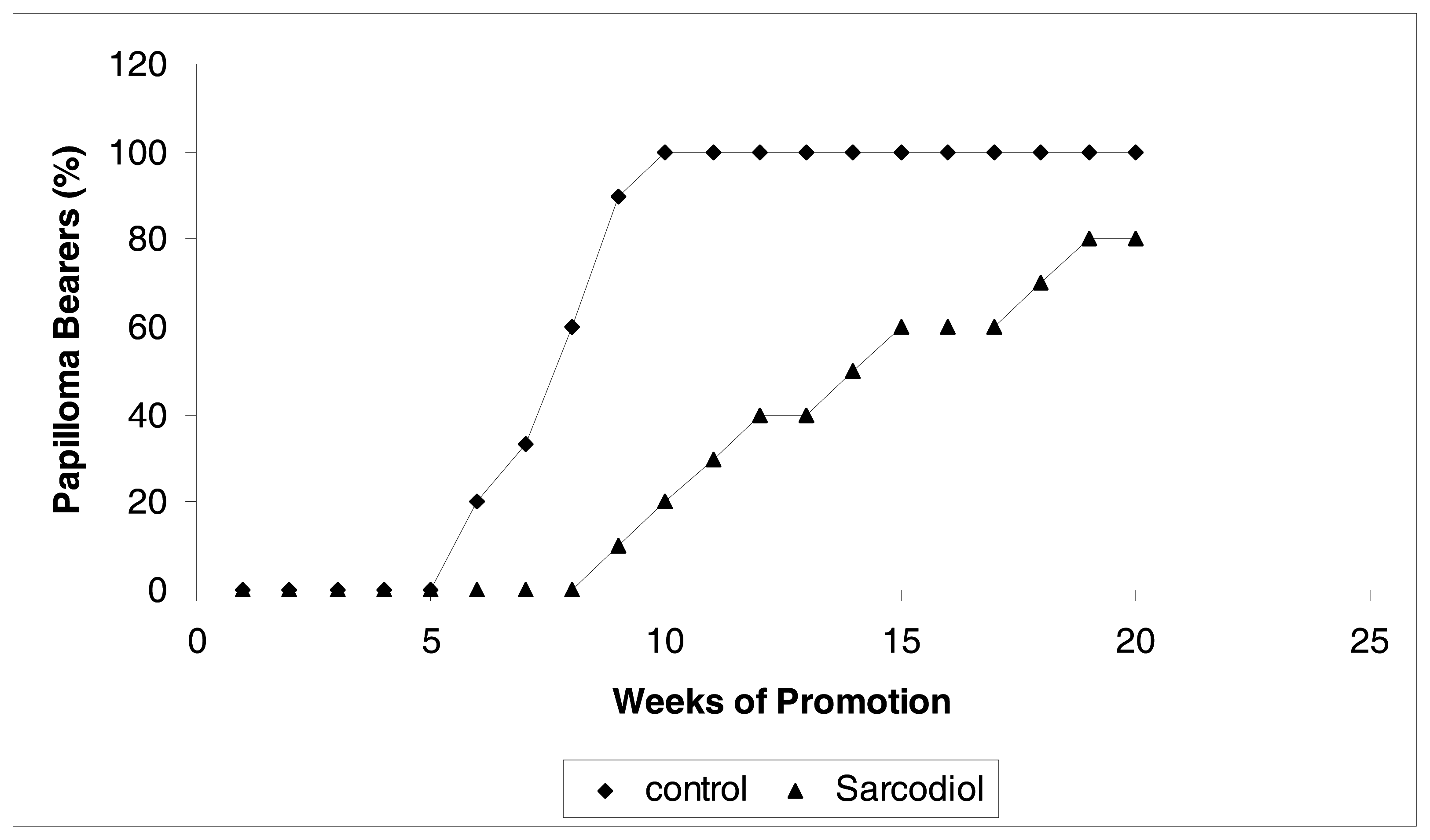
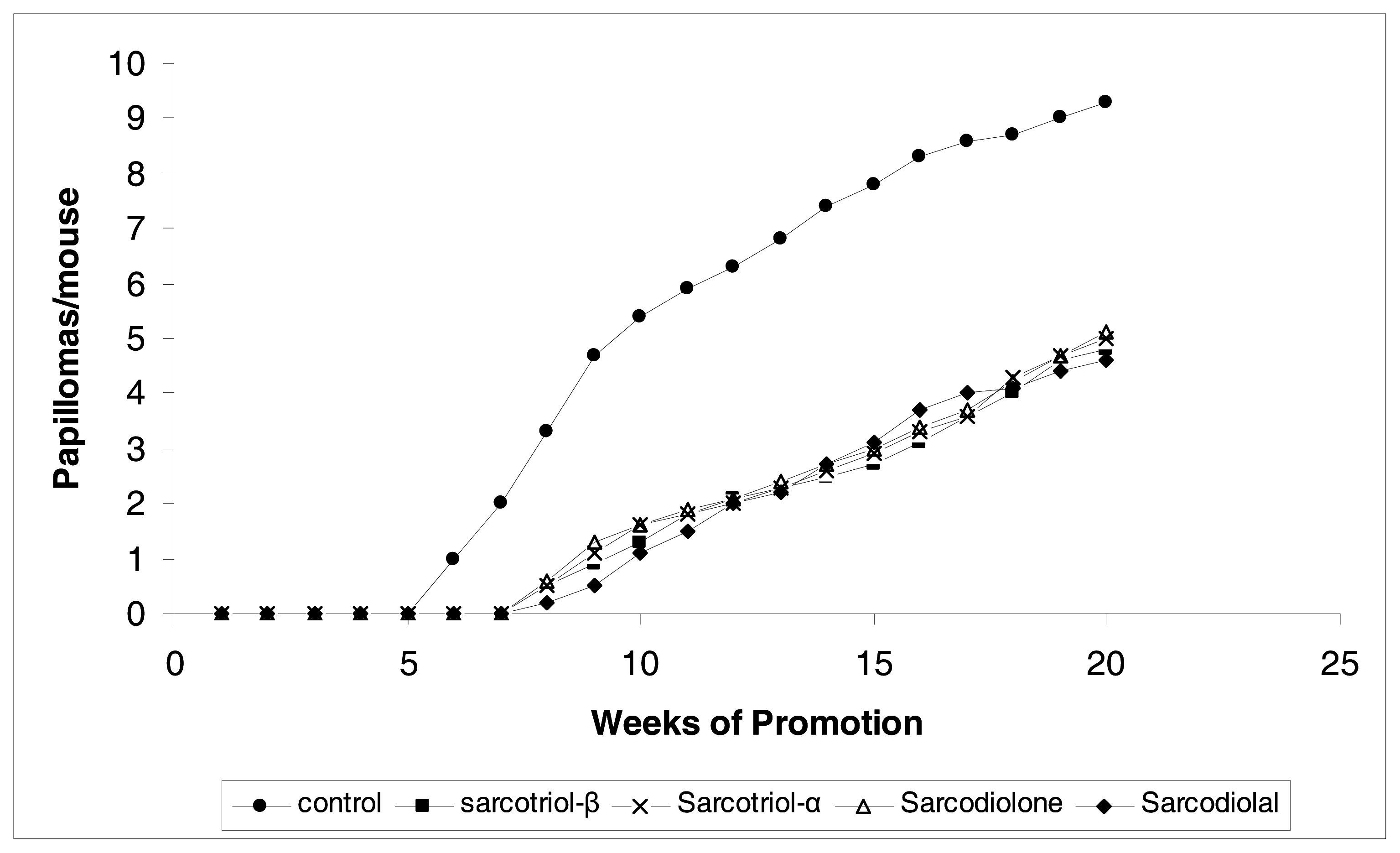
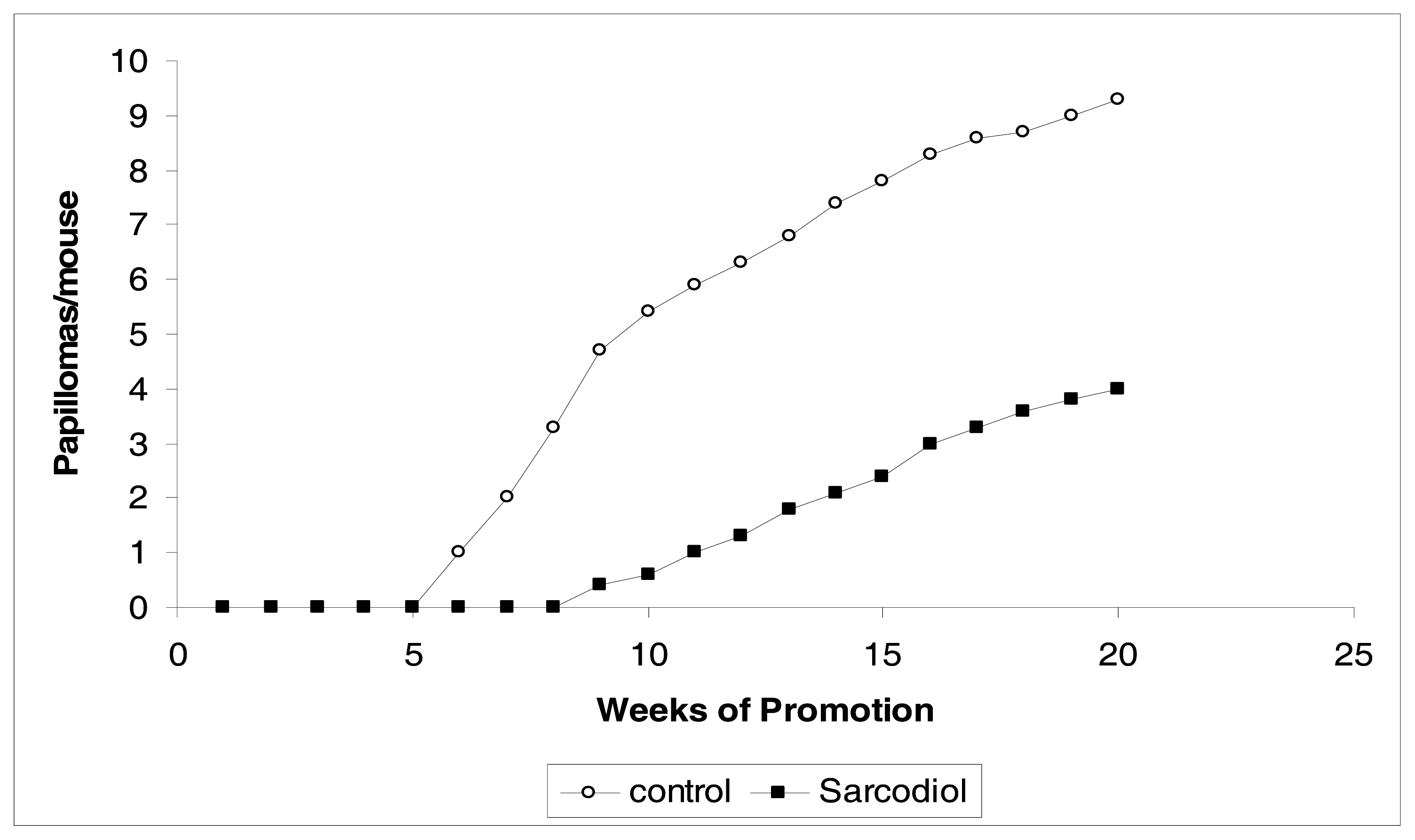
Acknowledgements
- Samples Availability: Available from the authors.
References
- Haefner, B. Drugs from the deep: Marine Natural Products as Drug Candidates. Drug Discovery Today 2003, 8, 536–544. [Google Scholar]
- Fujiki, H.; Suganuma, M; Takagi, K; Nishiwaki, S; Yoshizawa, S.; Okabe, S.; Yatsunami, J; Frenkel, K; Troll, W.; Marshall, J. A.; Tius, M. A. Sarcophytol A and its Analogs. Cancer Preventive Activity in Phenolic Compounds in Food and their effects on Health II. Antioxidants & Cancer Prevention. Huang, M-T, Ho, C-T, Lee, C.Y., Eds.; In ACS Symp. Series 507; American Chemical Scociety: Washintogton DC, 1991; pp. 380–387. [Google Scholar]
- Fujiki, H.; Suganuma, M; Komori, A.; Yatsunami, J; Okabe, S.; Ohta, T.; Sueoka, E. A New Tumor Promotion Pathway and its Inhibitors. Cancer Det. Prev 1994, 18, 1–7. [Google Scholar]
- Steele, V.E.; Moon, R. C.; Lubet, R.A.; Grubbs, C. J.; Reddy, B. S.; Wargrovich, M; McCormick, D. L.; Periera, M. A.; Crowell, J. A. Preclincal Efficacy Evaluation of Potential Chemopreventive Agents in Animal Carcinogenesis Models; Methods and Results from the NCI Chemoprevention Drug Development Program. J. Cell. Biochem 1994, suppl 20, 32–54. [Google Scholar]
- Saladi, R. N.; Persaud, A. N. The causes of skin cancer: a comprehensive review. Drugs of Today 2005, 41, 37–53. [Google Scholar]
- American Cancer Society Inc. Cancer facts and figures. 2006. http://www.cancer.org.
- Bachelor, M. A.; Bowden, G. T. UVA-mediated activation of signaling pathways involved in skin tumor promotion and progression. Semin. Cancer Biol 2004, 14, 131–138. [Google Scholar]
- Kelloff, G. J.; Hawk, E. T.; Sigman, C. C. (Eds.) Cancer Chemoprevention. Volume 2, In Strategies for Cancer Chemoprevention; Humana Press: Totowa, New Jersey, 2005.
- Agarwal, R; Mukhtar, H. 1991; Cutaneous chemical carcinogens. Mukhtar, H, Ed.; In Pharmacology of the skin; Boca Raton, FL; CRC Press, 1991; pp. 371–387.
- Stratton, M. S.; Stratton, S. P.; Ranger-Moore, J.; Einspahr, J. G.; Bowden, G. T.; Alberts, D.S. 2005; Strategies in skin cancer chemoprevention. Kelloff, G. J., Hawk, E. T., Sigman, C. C., Eds.; In Cancer Chemoprevention. Vol 2. Strategies for Cancer Chemoprevention; Humana Press: Totowa, New Jersey, 2005; pp. 403–419.
- Viner, J. L.; Hawk, E. T.; Richmond, E.; Higley, H; Umar, A. 2005; Opportunities and challenges for skin cancer chemoprevention. Kelloff, G. J., Hawk, E. T., Sigman, C. C., Eds.; In Cancer Chemoprevention. Vol 2. Strategies for Cancer Chemoprevention; Humana Press: Totowa, New Jersey, 2005; pp. 421–434.
- Boutwell, R. K. Some biological aspects of skin carcinogenesis. Prog. Exp. Tumor Res 1984, 4, 207–250. [Google Scholar]
- Boutwell, R. K. The function and mechanism of promoters of carcinogenesis. Crit. Rev. Toxicol 1974, 2, 419–443. [Google Scholar]
- Forbes, P. D. Relevance of animal models of photocarcinogenesis to humans. Photochem. Photobiol 1966, 63, 357–362. [Google Scholar]
- Zjawiony, J. K.; Fahmy, H.; Katsuyama, I; Khalifa, S.; Konoshima, T. Cembranoids of Chemopreventive Activity PCT Int. Appl. WO 2003095404, 2003.
- Katsuyama, I.; Fahmy, H.; Zjawiony, J. K.; Khalifa, S.; Kilada, R. W.; Konoshima, T.; Takasaki, M.; Tokuda, H. Semisynthesis of New Sarcophine Derivatives with Chemopreventive Activity. J. Nat. Prod 2002, 65, 1808–1814. [Google Scholar]
- Fahmy, H.; Khalifa, S.; Konoshima, T.; Zjawiony, J. K. An Improved Synthesis of 7,8-Epoxy-1,3,11-cembratriene-15R(α), 16-diol, A Cembranoid of Marine Origin With a Potent Cancer Chemopreventive Activity. Marine Drugs 2004, 1, 1–7. [Google Scholar]
- Fahmy, H.; Zjawiony, J. K.; Khalifa, S.; Fronczek, F. R. A Semi-synthetic Analog of The Cembranoid Sarcophine. Acta Cryst 2003, C59, 85–87. [Google Scholar]
- Fujiki, H.; Suganuma, M.; Komoro, A.; Yatsunami, J.; Okabe, S.; Ohta, T.; Sueoka, E. A New Tumor Promotion Pathway and its Inhibitors. Cancer Det. Prev 1994, 18, 1–7. [Google Scholar]
- Fujiki, H.; Suganuma, M.; Takagi, K.; Nishiwaki, S.; Yoshizawa, S.; Okabi, S.; Yatsunami, J.; Frenkel, K.; Troll, W.; Marshall, J. A.; Tues, M. A. Sarcophytol A and its analogs. Huang, M. T., Ho, C. T., Lee, C. Y., Eds.; In Cancer preventive activity in phenolic compounds in food and their effects on health II. Antioxidants & cancer prevention; ACS Symp Series 507; American Chemical Society: Washington DC, 1992; pp. 380–387. [Google Scholar]
- Takasaki, M.; Konoshima, T.; Komatsu, K.; Tokuda, H.; Nishino, H. Antitumor-promoting activity of lignans from the aerial part of Saussurea medusa. Cancer Letters 2000, 158, 53–59. [Google Scholar]
- Ne’eman, I.; Fishelson, L.; Kashman, Y. Sarcophine- a new toxin from the soft coral Sarcophyton glaucum (Alcyonaria). Toxicon 1974, 12, 593–598. [Google Scholar]
- Borenfreund, E.; Puerner, J. A. Toxicity determined in-vitro by morphological alterations and neutral red absorption. Toxicology Lett 1985, 24, 119–124. [Google Scholar]
© 2006 by MDPI Reproduction is permitted for noncommercial purposes.
Share and Cite
Fahmy, H.; Zjawiony, J.K.; Konoshima, T.; Tokuda, H.; Khan, S.; Khalifa, S. Potent Skin Cancer Chemopreventing Activity of Some Novel Semi-synthetic Cembranoids from Marine Sources. Mar. Drugs 2006, 4, 28-36. https://doi.org/10.3390/md402028
Fahmy H, Zjawiony JK, Konoshima T, Tokuda H, Khan S, Khalifa S. Potent Skin Cancer Chemopreventing Activity of Some Novel Semi-synthetic Cembranoids from Marine Sources. Marine Drugs. 2006; 4(2):28-36. https://doi.org/10.3390/md402028
Chicago/Turabian StyleFahmy, Hesham, Jordan K. Zjawiony, Takao Konoshima, Harukuni Tokuda, Shabana Khan, and Sherief Khalifa. 2006. "Potent Skin Cancer Chemopreventing Activity of Some Novel Semi-synthetic Cembranoids from Marine Sources" Marine Drugs 4, no. 2: 28-36. https://doi.org/10.3390/md402028
APA StyleFahmy, H., Zjawiony, J. K., Konoshima, T., Tokuda, H., Khan, S., & Khalifa, S. (2006). Potent Skin Cancer Chemopreventing Activity of Some Novel Semi-synthetic Cembranoids from Marine Sources. Marine Drugs, 4(2), 28-36. https://doi.org/10.3390/md402028



